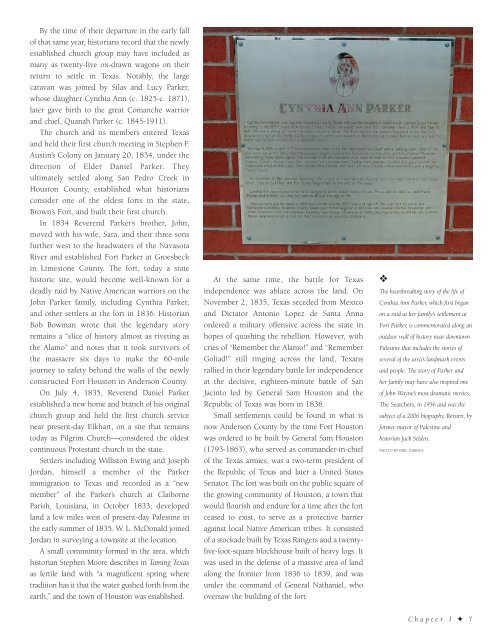Historic Palestine
An illustrated history of the Palestine, Texas area, paired with the histories of companies, families and organizations that make the region great.
An illustrated history of the Palestine, Texas area, paired with the histories of companies, families and organizations that make the region great.
Create successful ePaper yourself
Turn your PDF publications into a flip-book with our unique Google optimized e-Paper software.
By the time of their departure in the early fall<br />
of that same year, historians record that the newly<br />
established church group may have included as<br />
many as twenty-five ox-drawn wagons on their<br />
return to settle in Texas. Notably, the large<br />
caravan was joined by Silas and Lucy Parker,<br />
whose daughter Cynthia Ann (c. 1825-c. 1871),<br />
later gave birth to the great Comanche warrior<br />
and chief, Quanah Parker (c. 1845-1911).<br />
The church and its members entered Texas<br />
and held their first church meeting in Stephen F.<br />
Austin’s Colony on January 20, 1834, under the<br />
direction of Elder Daniel Parker. They<br />
ultimately settled along San Pedro Creek in<br />
Houston County, established what historians<br />
consider one of the oldest forts in the state,<br />
Brown’s Fort, and built their first church.<br />
In 1834 Reverend Parker’s brother, John,<br />
moved with his wife, Sara, and their three sons<br />
further west to the headwaters of the Navasota<br />
River and established Fort Parker at Groesbeck<br />
in Limestone County. The fort, today a state<br />
historic site, would become well-known for a<br />
deadly raid by Native American warriors on the<br />
John Parker family, including Cynthia Parker,<br />
and other settlers at the fort in 1836. Historian<br />
Bob Bowman wrote that the legendary story<br />
remains a “slice of history almost as riveting as<br />
the Alamo” and notes that it took survivors of<br />
the massacre six days to make the 60-mile<br />
journey to safety behind the walls of the newly<br />
constructed Fort Houston in Anderson County.<br />
On July 4, 1835, Reverend Daniel Parker<br />
established a new home and branch of his original<br />
church group and held the first church service<br />
near present-day Elkhart, on a site that remains<br />
today as Pilgrim Church—considered the oldest<br />
continuous Protestant church in the state.<br />
Settlers including Williston Ewing and Joseph<br />
Jordan, himself a member of the Parker<br />
immigration to Texas and recorded as a “new<br />
member” of the Parker’s church at Claiborne<br />
Parish, Louisiana, in October 1833, developed<br />
land a few miles west of present-day <strong>Palestine</strong> in<br />
the early summer of 1835. W. L. McDonald joined<br />
Jordan in surveying a townsite at the location.<br />
A small community formed in the area, which<br />
historian Stephen Moore describes in Taming Texas<br />
as fertile land with “a magnificent spring where<br />
tradition has it that the water gushed forth from the<br />
earth,” and the town of Houston was established.<br />
At the same time, the battle for Texas<br />
independence was ablaze across the land. On<br />
November 2, 1835, Texas seceded from Mexico<br />
and Dictator Antonio Lopez de Santa Anna<br />
ordered a military offensive across the state in<br />
hopes of quashing the rebellion. However, with<br />
cries of “Remember the Alamo!” and “Remember<br />
Goliad!” still ringing across the land, Texans<br />
rallied in their legendary battle for independence<br />
at the decisive, eighteen-minute battle of San<br />
Jacinto led by General Sam Houston and the<br />
Republic of Texas was born in 1836.<br />
Small settlements could be found in what is<br />
now Anderson County by the time Fort Houston<br />
was ordered to be built by General Sam Houston<br />
(1793-1863), who served as commander-in-chief<br />
of the Texas armies, was a two-term president of<br />
the Republic of Texas and later a United States<br />
Senator. The fort was built on the public square of<br />
the growing community of Houston, a town that<br />
would flourish and endure for a time after the fort<br />
ceased to exist, to serve as a protective barrier<br />
against local Native American tribes. It consisted<br />
of a stockade built by Texas Rangers and a twentyfive-foot-square<br />
blockhouse built of heavy logs. It<br />
was used in the defense of a massive area of land<br />
along the frontier from 1836 to 1839, and was<br />
under the command of General Nathaniel, who<br />
oversaw the building of the fort.<br />
❖<br />
The heartbreaking story of the life of<br />
Cynthia Ann Parker, which first began<br />
on a raid at her family’s settlement at<br />
Fort Parker, is commemorated along an<br />
outdoor wall of history near downtown<br />
<strong>Palestine</strong> that includes the stories of<br />
several of the area’s landmark events<br />
and people. The story of Parker and<br />
her family may have also inspired one<br />
of John Wayne’s most dramatic movies,<br />
The Searchers, in 1956 and was the<br />
subject of a 2006 biography, Return, by<br />
former mayor of <strong>Palestine</strong> and<br />
historian Jack Selden.<br />
PHOTO BY ERIC DABNEY.<br />
C h a p t e r I ✦ 7
















